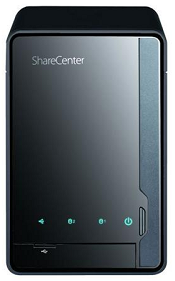This is an old revision of the document!
DNS-320
This page will share some more information about the ShareCenter Pulse (DNS-320).
Take a look at the DNS-320-Page on NAS-Tweaks for further Pictures.
Note: This page is in progress, as of today (November 22nd 2010) the device is still pretty new.
Hardware
Additional to the product specifications.
| CPU | 800 MHz Marvell 88F6281 (Kirkwood) |
|---|---|
| RAM | 128 MB |
| USB | 1 USB2.0 Port (front) |
| LAN | Marvell 88E1118R-NNC1 |
| Cooling | Speed controlled 40mm fan ? (verifying) |
| Kernel | 2.6.22.18 |
| Samba | 3.2.8 |
| C library | gcc-4.2-glibc-2.5 |
/proc/cpuinfo
Processor : ARM926EJ-S rev 1 (v5l) BogoMIPS : 791.34 Features : swp half thumb fastmult edsp CPU implementer : 0x56 CPU architecture: 5TE CPU variant : 0x2 CPU part : 0x131 CPU revision : 1 Cache type : write-back Cache clean : cp15 c7 ops Cache lockdown : format C Cache format : Harvard I size : 16384 I assoc : 4 I line length : 32 I sets : 128 D size : 16384 D assoc : 4 D line length : 32 D sets : 128 Hardware : Feroceon-KW Revision : 0000 Serial : 0000000000000000
Serial PIN Layout
BusyBox break-in code is still 5784468
Jumper: JP3
TX [5]
GND [4]
VD33 [3]
RX [1]
Setting up ffp
There is a complete Tutorial on the Installation of ffp available on NAS-Tweaks: Installation of fun_plug 0.5. If you want to do everything yourself instead, just follow the instructions below.
To get the fonz fun_plug running some small changes to the available ffp fun_plug file are needed.
Search and replace all entries of /mnt/HD_a2/ with /mnt/HD/HD_a2/.
Then follow the normal instructions of how to install ffp.
shadowandy has provided modified ffp package for DNS-320 here
Another article in German on installing fun_plug 0.5 can be found here
Once installed and running you might want to set-up ssh and change the root password. (for example this)
But to need to change store-passwd.sh also because that is functioning differently on our device. It can be found at /ffp/sbin/store-passwd.sh
And make it look like this:
#!/bin/sh echo "Copying files to /usr/local/config/..." cp -f /etc/passwd /usr/local/config/. cp -f /etc/group /usr/local/config/. cp -f /etc/shadow /usr/local/config/. cp -f /etc/samba/smbpasswd /usr/local/config/.
Setting up Debian in chrooted enviroment
D-Link has recently put a prebuilt Debian Squeeze package on their ftp site. The package size is approximately 150 MB. Read the instruction inside.
Source code for firmware
Dlink have release source code for firmware 1.0 on their ftp site. The source code size is approximate 25 MB
U-BOOT Configuration
You can access the boot console (for trying to run your own kernel) via a netconsole, the boot settings are:
bootargs=root=/dev/ram console=ttyS0,115200 :::DB88FXX81:egiga0:none bootcmd=nand read.e 0xa00000 0x100000 0x300000;nand read.e 0xf00000 0x600000 0x300000;bootm 0xa00000 0xf00000 bootdelay=1 baudrate=115200 loads_echo=0 ipaddr=2.76.88.201 serverip=2.76.88.2 rootpath=/mnt/ARM_FS/ netmask=255.255.255.0
Building a Custom Firwmware ("ROM")
D-Link provides a complete build environment on its ftp server that lets you create your own firmware images easily. Untar it and run
source build_fw
this will result in a file “DNS320-firmware” in the merge folder, which can be flashed to the unit via the webinterface (firmware update). Right now the build_fw script does not do a full rebuild of the complete firmware, it rather puts together precompiled binaries that come with the built environment. Here is an attempt at rebuilding the build script.
Other info
The following thread handles some DNS-320 initial conversation, request there if you want some specific info here, or add yourself.